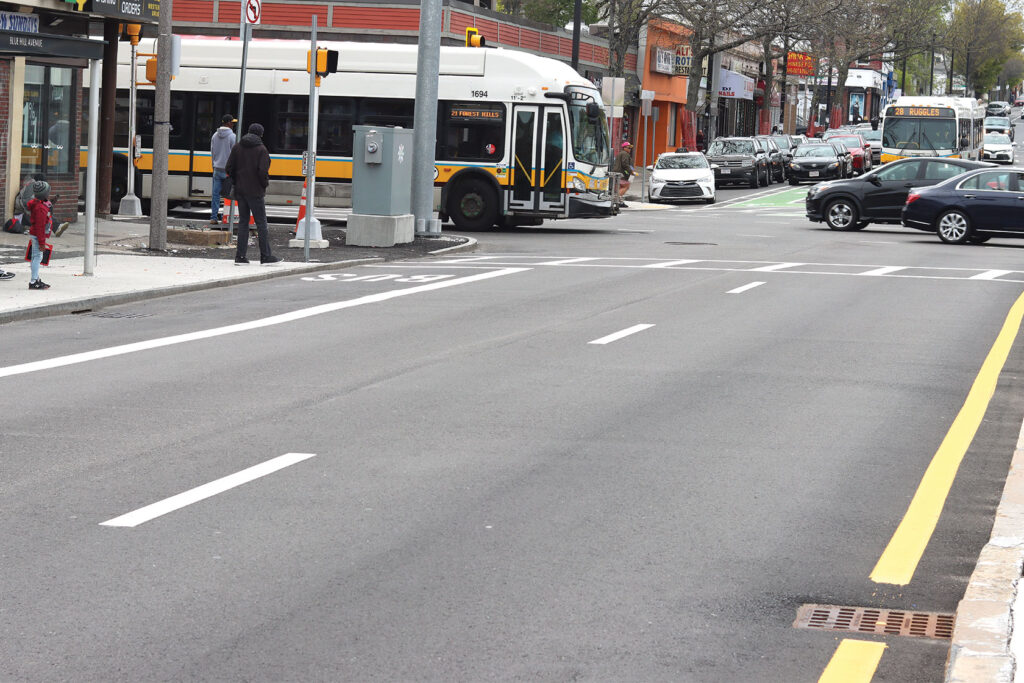City Proposes Blue Hill Ave. lane reductions
Residents question benefits of proposed changes

Two years after the first center-running bus lanes in New England opened on Columbus Avenue, Boston is pursuing another. Depending on feedback from residents, Blue Hill Avenue’s drivers could lose a lane.
Boston is soliciting resident input, asking everyone from Grove Hall to Mattapan Square to weigh in. Hosts of small meetings receive a $40 gift card. City planners are available in person at the Grove Hall Library Wednesday mornings.

Aerial view of Blue Hill Avenue. PHOTO: COURTESY BOSTON.GOV
Establishing ground rules for the Blue Hill Avenue Transportation Action Plan March meeting, a city consultant foreshadowed “a contentious conversation with the drastic changes that will be occurring.”
On April’s Zoom call last week — ostensibly discussing green infrastructure, residents contested the city’s stated position: favoring mid-road bus lanes on Blue Hill Avenue. They waited an hour to speak.
“I can’t understand the benefit of a center-lane … bus line from Mattapan Square to Grove Hall,” said Louis Elisa, president of Roxbury’s Garrison-Trotter Neighborhood Association. Garrison-Trotter is situated in Roxbury north of Columbus Avenue and west of Blue Hill Avenue.
“What is the benefit? And that’s what I keep asking you: What are you trying to achieve?” he asked.
In dialogue with the city over this for the last five years, Elisa had yet to see a definite plan for Blue Hill Avenue.
As an answer, city consultant Stephen Grey reiterated the government’s goals: improving pedestrian safety, balancing transit-modes and coordinating among multiple city and state departments.
To Grey, traveling cars pose a threat to pedestrians.
“Pedestrian safety is key, and it’s at odds with faster moving traffic,” he said.
A streetscape tailored to city goals will be presented to residents at upcoming public events.
Just such a data-driven process produced Columbus Avenue’s bus-centric layout. Published in 2017 and titled PLAN: JP/ROX, its study area stretched to Forest Hills.
Over two years, mostly Jamaica Plain residents discussed development along Washington Street at workshops held in their neighborhood: five at English High School and one at the Bromley-Heath Housing Development, now known as the Mildred Hailey Apartments.
The Garrison-Trotter neighborhood was left out of the study area. Jamaica Plain and Roxbury border one another along Columbus Avenue. Jamaica Plain has subway stations; most of Roxbury does not, making its residents more dependent on cars.
PLAN: JP/ROX described Columbus Avenue as “auto-oriented.”
The report determined “Columbus Avenue is a prime candidate for reduced lane widths, eliminating excessive lanes and removing the road’s center median. This will free up space for other uses, including protected bicycle facilities, bus priority lanes, and widened sidewalks. This kind of reimagining of a street is called a ‘road diet’.”
City transportation planners appear to have a road diet in mind for Blue Hill Avenue.
Garrison-Trotter’s residential streets have conveyed cut-through traffic ever since Columbus Avenue’s reconstruction. The bus lanes from Walnut Avenue to Jackson Square opened in October 2021.
“The quality of life in my neighborhood has been profoundly affected by people who are trying to get around the obstructions you created along Columbus Avenue,” Elisa said.
Apparently acknowledging the diverted traffic, Boston’s Transportation Department “recently completed a speed hump program within the Garrison-Trotter neighborhood,” said Charlotte Fleetwood, a city planner.
More than 90 speed bumps were installed 200 to 300 feet apart on 40 city blocks.
A city study previewed last week clocked 5% more traffic along Walnut Avenue after the new bus lanes opened. It was commissioned to address complaints about Columbus Avenue bus lanes.
The study’s data provider, StreetLight, did not answer questions about their data sources or how accurately they predict the future.
Other residents spoke up at April’s public meeting, including a Boston native, Pam Green. She graded the Columbus Avenue project “a high D minus.”
“I know you want to do green space, but we need more — it seems like it’s more cars — everybody got a car,” she said.
Green also lamented the project’s impact on parking around Jackson Square.
“I used to park and get on the train. Now you can’t even do that,” she said. “So where [are] all these people parking?”
For Grey, Green touched on the need to balance different transit modes.
“A center-running bus lane means faster moving buses, but you know, one less lane for moving cars. A side running bus lane means now it’s on the curb, but now there’s less parking,” he said.
Grey added, “We need a balanced approach to drivers because this is actually a Black neighborhood in the United States of America where a lot of people own cars.”
He called for residents to accept trade-offs: “What are you willing to give up a little bit of to get a little bit of something else?”
Another speaker, who identified herself only as Ruth G., appreciated the urgency.
“What I would add, as someone who travels regularly on Blue Hill, there is a need for massive change on Blue Hill,” she said. “And that’s just the reality of it.”
As a resident of Roxbury when the new lanes opened, she acknowledged others’ frustration. She said traffic from a fast-food drive-thru spills out onto Columbus, blocking traffic. She recommended communicating with businesses.
Towards the end of the meeting, Stephen Grey, a city consultant, reviewed next steps: “We are moving very quickly now, it’s been a couple of years that we’ve been engaging you on a monthly basis — or it’s been a year now — but we are moving quickly to start the design process.”






